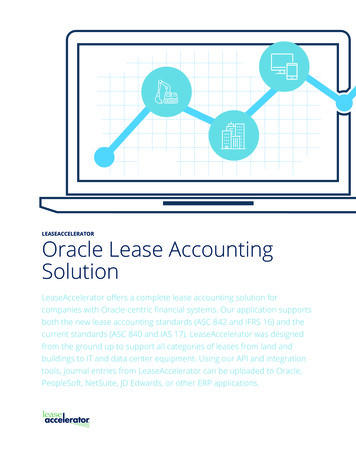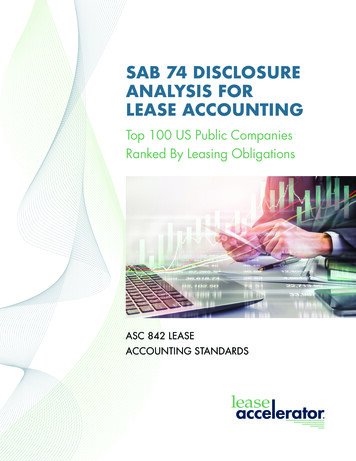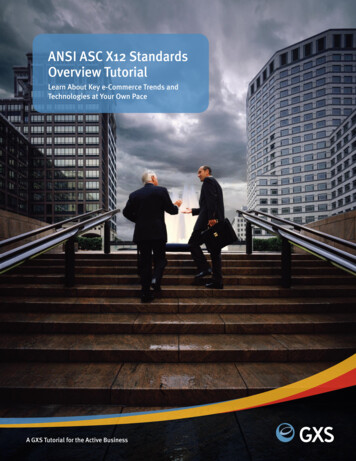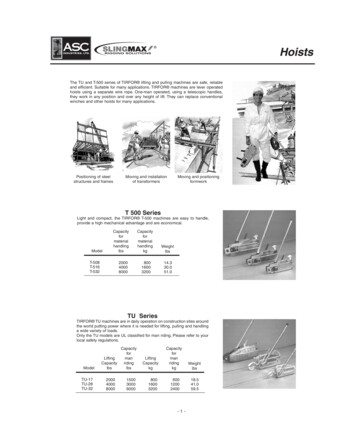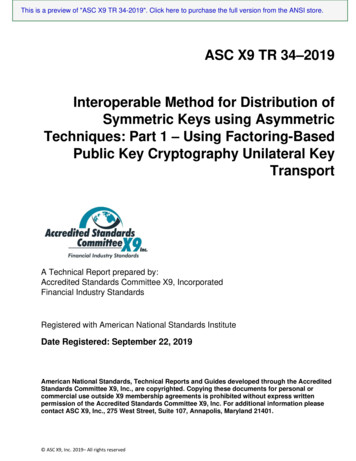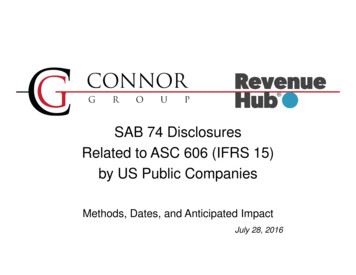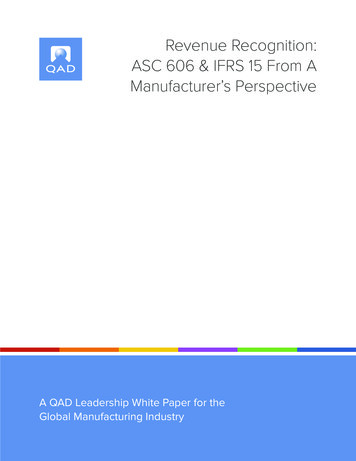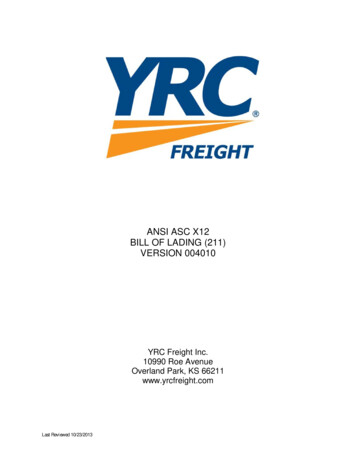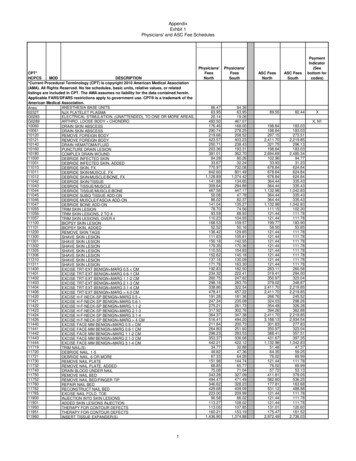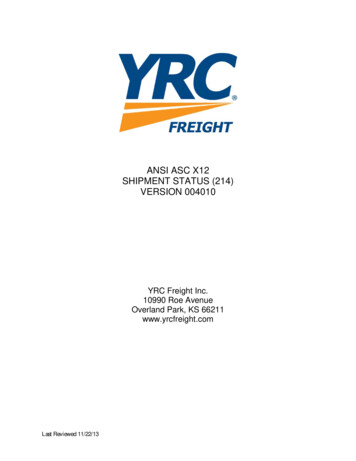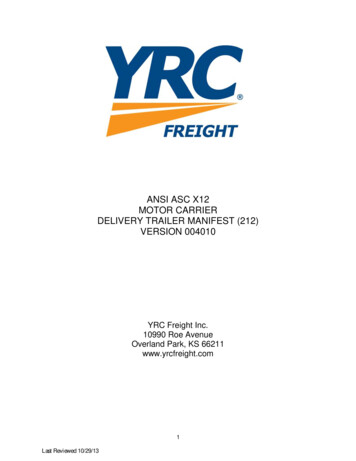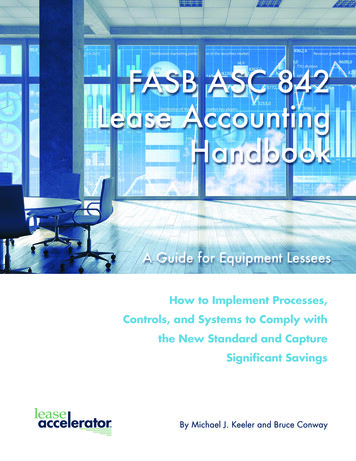
Transcription
FASB ASC 842Lease AccountingHandbookA Guide for Equipment LesseesHow to Implement Processes,Controls, and Systems to Comply withthe New Standard and CaptureSignificant SavingsBy Michael J. Keeler and Bruce Conway
ContentsIntroduction to the New Lease Accounting Standards . . . . . . . . . . . . . . . . . . . . . . . . . . . . . . . . 3Exhibit 1: Executive Summary of Proposed Lease Accounting Rules . . . . . . . . . . . . . . . . . . . . . . . . . . . . 5Compliance Requirements . . . . . . . . . . . . . . . . . . . . . . . . . . . . . . . . . . . . . . . . . . . . . . . . . . . . . . 5Purpose of This Handbook . . . . . . . . . . . . . . . . . . . . . . . . . . . . . . . . . . . . . . . . . . . . . . . . . . . . . . 6I. The New Lease Accounting Standard: Timing, Key Provisions andChanges in Direction . . . . . . . . . . . . . . . . . . . . . . . . . . . . . . . . . . . . . . . . . . . . . . . . . . . . . . 7Final Lease Accounting Standards Issued . . . . . . . . . . . . . . . . . . . . . . . . . . . . . . . . . . . . . . . . . . . . . 7Exhibit 2: Expected New Lease Accounting Rule Timeline . . . . . . . . . . . . . . . . . . . . . . . . . . . . . . . . . . 7Key Changes in the Re-Exposure Draft . . . . . . . . . . . . . . . . . . . . . . . . . . . . . . . . . . . . . . . . . . . . . . . 7Exhibit 3: Lease Accounting Under the New Standard: A Real-World Example . . . . . . . . . . . . . . . . . . . 9Evolution of Key Issues Regarding Lease Payments . . . . . . . . . . . . . . . . . . . . . . . . . . . . . . . . . . . . . 10Impact of New Standard . . . . . . . . . . . . . . . . . . . . . . . . . . . . . . . . . . . . . . . . . . . . . . . . . . . . . . 11 To Meet the Timetable for Implementation, Lessee Companies Must Begin Preparing Now . . . . . . . . . . . 12Setting Objectives and Defining Compliance and ROI Success . . . . . . . . . . . . . . . . . . . . . . . . . . . . . 12II. T ransitioning to the New Standard: How to Meet the New Requirementsand Drive Savings and ROI . . . . . . . . . . . . . . . . . . . . . . . . . . . . . . . . . . . . . . . . . . . . . . . 14Introduction . . . . . . . . . . . . . . . . . . . . . . . . . . . . . . . . . . . . . . . . . . . . . . . . . . . . . . . . . . . . . . .Sale/Leaseback Transactions . . . . . . . . . . . . . . . . . . . . . . . . . . . . . . . . . . . . . . . . . . . . . . . . . . .Lessee Benefits That Continue . . . . . . . . . . . . . . . . . . . . . . . . . . . . . . . . . . . . . . . . . . . . . . . . . . .Transitioning to the New Standard: A Comprehensive 9-Step Process . . . . . . . . . . . . . . . . . . . . . . . . .The Bottom Line: Deadline For Data is 2017 . . . . . . . . . . . . . . . . . . . . . . . . . . . . . . . . . . . . . . . . .Start the Project Now . . . . . . . . . . . . . . . . . . . . . . . . . . . . . . . . . . . . . . . . . . . . . . . . . . . . . . . . .Consider On-demand Lease Accounting and Portfolio Management Software . . . . . . . . . . . . . . . . . . .Consider Outsourcing: Drive Maximum Savings Quickly . . . . . . . . . . . . . . . . . . . . . . . . . . . . . . . . .1415161621222222 ppendix I: Major Compliance Requirements under Lease AccountingAExposure Draft . . . . . . . . . . . . . . . . . . . . . . . . . . . . . . . . . . . . . . . . . . . . . . . . . . . . . . . . . . . 23New Rules Compliance Requirements . . . . . . . . . . . . . . . . . . . . . . . . . . . . . . . . . . . . . . . . . . . . . . 23 ppendix II: Details of Recommended Actions for ImplementingAStep 3 of the 9-Step Process . . . . . . . . . . . . . . . . . . . . . . . . . . . . . . . . . . . . . . . . . . . . . . . . . . 26Step 3: Establish a Totally New, Retrospective Lease Information Database . . . . . . . . . . . . . . . . . . . . . 26 ppendix III: Details of Recommended Actions for ImplementingAStep 6 of the 9-Step Process . . . . . . . . . . . . . . . . . . . . . . . . . . . . . . . . . . . . . . . . . . . . . . . . . . 28Step 6: Maintain Database Accuracy and Completeness . . . . . . . . . . . . . . . . . . . . . . . . . . . . . . . . . 28About the Authors . . . . . . . . . . . . . . . . . . . . . . . . . . . . . . . . . . . . . . . . . . . . . . . . . . . . . . . . . 30 2010-2016 LeaseAccelerator, Inc. All rights reserved. This document is the copyrighted work of LeaseAccelerator, Inc.
Introduction to the New Lease Accounting StandardsIn moving toward the goal of global accountingstandards, the Financial Accounting Standards Board(“FASB”) in the U.S. and the International AccountingStandards Board (“IASB”) have been working jointlyon a replacement for the current lease accountingstandards, ASC 840 (previously FAS 13) and IAS 17,respectively, since 2006. The project has finally beencompleted with the FASB and IASB issuing separatestandards on February 25, 2016 and January 13,2016, respectively. The new FASB ASU (AccountingStandards Update) is Leases (Topic 842).For public companies, the ASU is effective for fiscalyears, and interim periods within those fiscal years,beginning after December 15, 2018. Thus, for acalendar-year company, it would be effectiveJanuary 1, 2019.A public company is any organization that is any oneof the following:1. A public business organization2. A not-for-profit organization that has issued, or is aconduit bond obligor for, securities that are traded,listed, or quoted on an exchange or an over- thecounter market3. An employee benefit plan that files or furnishesfinancial statements to the SEC.For all other organizations, the ASU is effective forfiscal years beginning after December 15, 2019, andfor interim periods within fiscal years beginning afterDecember 15, 2020.Early application is permitted for all organizations. It isnot expected that any lessee with significant leases willearly adopt for two reasons. First the transition processis a huge undertaking as all existing operating leaseshave to be identified, documents read, lease paymentsextracted, gross/bundled billed payments separated,payments and terms input into system. Once theseactions are completed, then you are ready to accountfor the leases. The second reason that early adoptionmay not be advisable is that the addition of new assetswill cause Return on Assets (ROA) measures to declineFASB ASC 842 Lease Accounting Handbookand ROA is a measure investors key on, comparingROA to peer company ROAs.The following is a table to help understand when yourcompany would have to transition to the new rules:IF YOUR YEAREND IS:YOU MUST TRANSITION TO THE NEWRULES IN YOUR FINANCIAL STATEMENTSFOR THE YEAR ENDED:December 31December 31, 2019March 31March 31, 2020June 30June 30, 2020September 30September 30, 2020The primary objective of this project is to requirecompanies worldwide to capitalize operating leasesand thus to include them on their balance sheets asassets and liabilities for the purpose of giving usersof financial statements information on operatinglease obligations that they typically estimate for theirparticular analytical purposes. Under the current rules,operating leases are accounted for off-balance sheetand a table of future operating lease obligations aredisclosed in the footnotes to the company’s financialstatements. Since most users of financial statementsestimate lease assets and obligations to adjust theirfinancial ratios and measures, the Boards believethat users of financial statements will have more usefulinformation when operating leases are capitalized in auniform way and included as assets and liabilities on alessee company’s balance sheet.The FASB and IASB (the “Boards”) have madesignificant changes to the approach presented in theRe-Exposure Draft (the “RED”) issued in May 2013.They received more than 648 responses as of May2015, many of which challenged the Boards toaddress the classification controversy, complexity, andcost of implementation for lessees.The most notable change is that the boards have spliton lessee lease classification and how lessees accountfor capitalized operating leases. For lessees, the IASB3
would drop lease classification and apply what wenow know as capital lease accounting, which theBoards refer to as “finance lease accounting—note thename change, to all leases with a term of more than12 months and leases of small (meaning low value)items can be exempted from capitalization. Financelease accounting is where an asset and liability arerecorded at the present value of the lease payments,the asset is depreciated straight line, and interest isimputed on the liability. The IASB short term and smallticket exemption (assets with a cost of 5,000 or less)allows those leases to continue to be accounted foras off-balance sheet operating leases. The FASB hasdecided to retain a lessee lease classification modelsimilar to the current model with the 75% and 90%“bright lines” used as guidance in the useful life andpresent value tests. As a result operating type leaseswill be capitalized but accounted for differently fromfinance leases (note the name change, that is no longercalled capital leases) and will continue to be calledoperating leases. The present value of the operatinglease payments will be recorded as a separate assetand liability and the P&L expense will remain as thestraight line average rent expense. Most notable isthe operating lease liability will not be classified asdebt, but rather as an “other” operating liability. This issignificant as it will not impact debt covenants that limitdebt. The FASB allows a short term lease (12 months orless) exemption, but not a small ticket exemption.The wording of the FASB lease classification tests are:A lessee shall classify a lease as a finance lease if thelessee effectively obtains control of the underlying assetas a result of the lease. A lessee effectively obtainscontrol of the underlying asset when the lease meetsany of the following criteria at lease commencement:a. The lease transfers ownership of the underlyingasset to the lessee by the end of the lease term.b. T he lease grants the lessee an option to purchasethe underlying asset that the lessee is reasonablycertain to exercise.c. The lease term is for the major part of the remainingeconomic life of the underlying asset.d. The sum of the present value of the lease paymentsand the present value of any residual valueguaranteed by the lessee amounts to substantiallyall of the fair value of the underlying asset.4e. The underlying asset is of such a specialized naturethat it is expected to have no alternative use to thelessor at the end of the lease term.When determining lease classification, one reasonableapproach to assessing the criteria would be toconclude both of the following:a. Seventy-five percent or more of the remainingeconomic life of the underlying asset is a majorpart of the remaining economic life of thatunderlying asset.b. Ninety percent or more of the fair value of theunderlying asset amounts to substantially all the fairvalue of the underlying asset.The new accounting rules will represent a significantchange from current US Generally AcceptedAccounting Principles (GAAP), as not only willoperating leases be capitalized, but also the definitionof a lease payment will be expanded to include certainvariable rents as well as contractual payments, whereasonly the expected payment under a residual guaranteeis considered a lease payment. The determination asto whether renewal or purchase options are includedin lease payments is unchanged except for changesin wording. The FASB has softened the requirementsto have variable rents and renewal rent assumptionssubject to review and adjustment during the lease termto only when it is reassessing the lease liability for otherreasons (for example, when there is a change to thelease term). An exception is the expected paymentunder a residual guarantee must be reviewed andadjusted at least annually. The IASB requires rebookingwhenever a variable rent changes the future contractualpayments. In addition, under the new standard, theIASB lease cost pattern for capitalized operating leaseswill be front- ended, rather than straight-lined as underthe current rules. The FASB lease expense accountingfor capitalized operating leases is the same as currentGAAP, where you report the average rent expense.Since the lease is capitalized, the P&L rent expenseis a combination of imputed interest and amortizationof the asset such that the sum of the two results in astraight line rent expense. Accounting, compliance, andrecord keeping for operating leases will be much morecomplex.FASB ASC 842 Lease Accounting Handbook
Exhibit 1: Executive Summary ofProposed Lease Accounting RulesTimeline: The final standard issued in 2016. Transition date January 1, 2019 for publiccompanies with December 31 year end.New Lessee Accounting Standard Summary Capitalize all leases (except those exempted asnoted above) at the PV of payments. For the IASB all capitalized leases will have a P&Lpattern that is front ended – rent expense replacedby straight line amortization of the asset and imputedinterest on the liability, now called Finance leases.For the FASB there will . The lease term is to be the same as the current GAAPdefinition. The initial measurement of variable lease paymentsincluded in lease assets and lease liabilities includesonly variable lease payments that depend on anindex or a rate, measured using the index or rate atlease commencement.Variable rents based on a rate (e.g. LIBOR) or anindex (i.e. CPI) are booked based on spot rates.Variable rents based on usage or lessee performance(e. g. sales) are not booked unless intended as a tool toavoid capitalization (also known as disguised minimumlease payments which will have to be estimated andcapitalized).For the FASB, one should reassess and book variablelease payments that depend on an index or a rateonly when the lessee is reassessing the lease liabilityfor other reasons (for example, when there is a changeto the lease term upon the occurrence of a significantevent or a significant change in circumstances withinthe control of the lessee). The changed lease paymentdue to changes in the rate or index still need to betracked to provide footnote disclosure of future leasepayments. The IASB voted to reassess whenever achange in the reference index or rate in a variable rentclause changes the future contractual rents.FASB ASC 842 Lease Accounting Handbook Short term leases (with terms of 12 months or less),including renewals where the lessee is reasonablycertain to exercise to renew, can elect to use thecurrent operating lease method (off-balance sheet)with additional disclosure. For the IASB, low dollarvalue leases of 5,000 or less (even if material inthe aggregate) can continue to be accounted for asoperating leases (off-balance sheet), if so elected.Compliance RequirementsThe compliance requirements under the proposed newstandard are complex, and it will take significant workfor companies to transition their accounting for existingleases to the new rules and establish a process foraccounting for future leases.Most companies are not currently prepared for thetransition to the new standard. All leases have to beidentified and data has to be extracted from the leasedocuments to meet the proposed new requirements.Companies don’t have systems in place to capturethe additional lease information that will be requiredunder the new rules, nor account for the newlycapitalized leases. When these new rules do takeeffect, most US-based public companies will needto show comparable balance sheets for at least oneyear prior, meaning both 2019 and 2018, and P&Lstatements for two or three (for larger companies) yearsfor SEC purposes, but they have not yet systematizedthe input of all the data required for those comparableyears. These systems and process related issues areconsidered to be one of the main reasons the effectivedate is 2019. The date seems far out but do not delayin your transition planning.Multinational companies may have local reportingneeds so they may have to keep both FASB and IASBstyle records for capitalized operating leases. There willbe cases where an IASB company may have to reportoperating leases using the FASB method—examplesare when lenders request a break out of operatingleases from capital leases, to comply with property taxrules that only apply to capital leases and for regulatedentities that do not require capital for operating leaseassets. Without adequate and flexible systems thesecomplex record keeping needs will be onerous.5
To meet the deadline for implementation of thenew standard, it is critical that companies begin toprepare immediately. Since companies may needto prepare comparative P&L statements beginningin 2017 for SEC reporting, that leaves little time forthem to establish effective systems and processes forcompliance. For many companies (especially large,multinational companies with multiple lines of business),it will likely take significant planning to prepare; andhave all systems implemented and ready for the newstandard.Purpose of This HandbookThis handbook will help you get prepared in time tomeet the requirements of the new lease accountingstandard. It focuses on lessee accounting, leaseadministration, and operational impacts for lessees withequipment and real estate leases. While focused oncompliance, it also provides suggestions about how todrive cost savings and return-on-investment (ROI) as youcarry out an implementation plan.After first reviewing the current status of the LeaseAccounting Project, this paper will provide CFOs,Treasurers, Controllers, and other departments involvedwith lease activities and the reporting thereof, withadvice and detailed guidance on how to mosteffectively gear up to meet the compliance requirementsand internal fiduciary responsibilities.To meet the compliance deadline, companies shouldstart now to prepare by: (1) forming a project teamwith representatives of all departments involved in theleasing process (including Finance/Treasury, LeaseAdministration, IT, Accounting, and the Business Units);(2) becoming familiar with the requirements of thenew lease accounting standards; and (3) developprocesses, systems, and controls that will record allnecessary data required for compliance by followingthe 9-Step Transition Process detailed in the second partof this handbook.6While this paper is aimed at guiding you to timelycompliance with the new standard, preparing for andimplementing these rules will also yield an importantsecondary benefit. The transition process, if carriedout properly, will result in significant efficiencies andsavings, and thus a meaningful return on the requiredspending— rather than being exclusively a compliancecost. The savings is generated by improving economicdecision-making and red
n moving toward the goal of global accounting standards, the Financial Accounting Standards Board (“FASB”) in the U .S . and the International Accounting Standards Board (“IASB”) have been working jointly on a replacement for the current lease accounting standards, ASC 840 (previously
